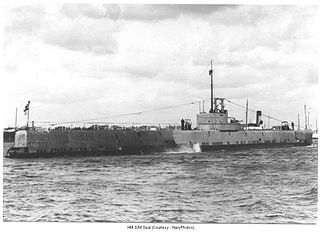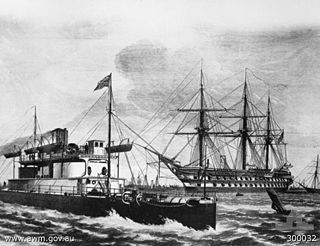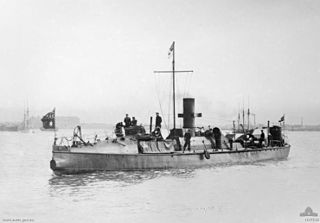
The Royal Norwegian Navy is the branch of the Norwegian Armed Forces responsible for naval operations of Norway, including those of the Norwegian Coast Guard. As of 2008, the Royal Norwegian Navy consists of approximately 3,700 personnel and 70 vessels, including 4 heavy frigates, 6 submarines, 14 patrol boats, 4 minesweepers, 4 minehunters, 1 mine detection vessel, 4 support vessels and 2 training vessels.

The Royal Danish Navy is the sea-based branch of the Danish Armed Forces force. The RDN is mainly responsible for maritime defence and maintaining the sovereignty of Danish territorial waters. Other tasks include surveillance, search and rescue, icebreaking, oil spill recovery and prevention as well as contributions to international tasks and forces.

Queenscliff is a small town on the Bellarine Peninsula in southern Victoria, Australia, south of Swan Bay at the entrance to Port Phillip. It is the administrative centre for the Borough of Queenscliffe. At the 2016 census, Queenscliff had a population of 1,315.

"The Rip", also known as "The Heads", is the narrow waterway entrance connecting the Bass Strait to the bay of Port Phillip in southern Victoria, Australia, and is the only route of maritime transport into Port Phillip and thus seaport access into Melbourne and Geelong, Victoria's two largest cities. Because of large tidal flows through the relatively narrow channel from the bay to the ocean, and a high rocky seabed, The Rip is a dangerous stretch of water and has claimed numerous ships and many lives. Geographically, it is the roughly triangular area of water between the land points of Point Nepean on the Mornington Peninsula, Shortlands Bluff and Point Lonsdale on the Bellarine Peninsula, with these three forming The Heads.

HMS Seal was one of six Grampus-class mine-laying submarines of the Royal Navy. She served in the Second World War and was captured by the Kriegsmarine and taken into German service as UB, one of several captured subs. She was the only submarine the Germans captured at sea during World War II. Her capture allowed the Germans to correct a critical fault in their U-boat torpedoes.

Before Federation in 1901 five of the six separate colonies maintained their own naval forces for defence. The colonial navies were supported by the ships of the Royal Navy's Australian Station which was established in 1859. The separate colonies maintained control over their respective navies until 1 March 1901, when the Commonwealth Naval Forces was created.

HMQS Mosquito was a torpedo boat operated by the Queensland Maritime Defence Force and Commonwealth Naval Forces. She entered service in 1885 and after Federation was transferred to the Commonwealth Naval Forces, serving as a training vessel until she was paid off in 1910.

Fort Queenscliff, in Victoria, Australia, dates from 1860 when an open battery was constructed on Shortland's Bluff to defend the entrance to Port Phillip. The Fort, which underwent major redevelopment in the late 1870s and 1880s, became the headquarters for an extensive chain of forts around Port Phillip Heads. Its garrison included volunteer artillery, engineers, infantry and naval militia, and it was manned as a coastal defence installation continuously from 1883 to 1946. The other fortifications and armaments around the Heads were completed by 1891, and together made Port Phillip one of the most heavily defended harbours in the British Empire.
HMS E52 was a British E-class submarine built by William Denny and Brothers, Dumbarton, entering service in 1917. She sank the U-boat UC-63 near the Goodwin Sands on 1 November 1917. E52 was sold in 1921 and later hulked on the River Dart.

Coastal Motor Boat was a small high-speed British torpedo boat used by the Royal Navy in the First World War and up to end of the Second World War.

The QF 14-pounder was a 3-inch medium-velocity naval gun used to equip warships for defence against torpedo boats. It was produced for export by Maxim-Nordenfelt in competition with the Elswick QF 12-pounder 12 cwt and QF 12-pounder 18 cwt guns.

HMVS Countess of Hopetoun was a 1st Class Torpedo Boat of the Victorian Naval Forces, Commonwealth Naval Forces and the Royal Australian Navy. She was named after Hersey, Countess of Hopetoun and later Marchioness of Linlithgow, the wife of the 7th Earl of Hopetoun, the then Governor of Victoria and later the first Governor-General of Australia.

HMVS Childers was a torpedo boat of the Victorian Naval Forces, Commonwealth Naval Forces and the Royal Australian Navy.
HMVS Gordon was a torpedo boat operated by the Victorian Naval Forces, the Commonwealth Naval Forces, and the Royal Australian Navy. She was launched in 1884 and lost in an accident in 1914.
HMVS Nepean was a Victorian Naval Forces second-class torpedo boat and was later operated by the Commonwealth Naval Forces and the Royal Australian Navy.
One ship and one naval depot of the Royal Australian Navy (RAN) have been named HMAS Lonsdale, after William Lonsdale, who supervised the founding of the settlement at Port Phillip.

The Queenscliffe Maritime Museum is a regional maritime museum in the town of Queenscliff at the entrance from Bass Strait to the bay of Port Phillip in Victoria, south-eastern Australia. It lies within walking distance of the Searoad ferry terminal. It covers the maritime history of the Borough of Queenscliffe, southern Port Phillip and the connection with Bass Strait.

HMS Valentine was a V and W-class destroyer, built in 1917 for the Royal Navy. She fought in both world wars, serving in several capacities. She was heavily damaged by air attack and beached in 1940 near Terneuzen. Her hulk remained there until it was broken up in 1953.

HMS Trollope (K575) was a British Captain class frigate of the Royal Navy in commission during World War II. Originally constructed as a United States Navy Buckley class destroyer escort, she served in the Royal Navy from January to July 1944, when she was lost.

The Queenscliffe Historical Museum is a regional cultural history museum in the town of Queenscliff, Victoria, Australia. The museum is part of the Museum Accreditation Program (MAP).
















